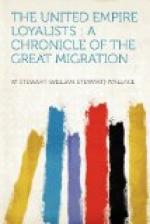The home of the average Loyalist was a log-cabin. Sometimes the cabin contained one room, sometimes two. Its dimensions were as a rule no more than fourteen feet by eighteen feet, and sometimes ten by fifteen. The roofs were constructed of bark or small hollowed basswood logs, overlapping one another like tiles. The windows were as often as not covered not with glass, but with oiled paper. The chimneys were built of sticks and clay, or rough unmortared stones, since bricks were not procurable; sometimes there was no chimney, and the smoke was allowed to find its way out through a hole in the bark roof. Where it was impossible to obtain lumber, the doors were made of pieces of timber split into rough boards; and in some cases the hinges and latches were made of wood. These old log cabins, with the chinks between the logs filled in with clay and moss, were still to be seen standing in many parts of the country as late as fifty years ago. Though primitive, they seem to have been not uncomfortable; and many of the old settlers clung to them long after they could have afforded to build better. This was doubtless partly due to the fact that log-houses were exempt from the taxation laid on frame, brick, and stone structures.
A few of the Loyalists succeeded in bringing with them to Canada some sticks of furniture or some family heirlooms. Here and there a family would possess an ancient spindle, a pair of curiously-wrought fire-dogs, or a quaint pair of hand-bellows. But these relics of a former life merely served to accentuate the rudeness of the greater part of the furniture of the settlers. Chairs, benches, tables, beds, chests, were fashioned by hand from the rough wood. The descendant of one family has described how the family dinner-table was a large stump, hewn flat on top, standing in the middle of the floor. The cooking was done at the open fireplace; it was not until well on in the nineteenth century that stoves came into common use in Canada.
The clothing of the settlers was of the most varied description. Here and there was one who had brought with him the tight knee-breeches and silver-buckled shoes of polite society. But many had arrived with only what was on their backs; and these soon found their garments, no matter how carefully darned and patched, succumb to the effects of time and labour. It was not long before the settlers learnt from the Indians the art of making clothing out of deer-skin. Trousers made of this material were found both comfortable and durable. ’A gentleman who recently died in Sophiasburg at an advanced age, remembered to have worn a pair for twelve years, being repaired occasionally, and at the end they were sold for two dollars and a half.’ Petticoats for women were also made of deer-skin. ‘My grandmother,’ says one descendant, ’made all sorts of useful dresses with these skins, which were most comfortable for a country life, and for going through the bush [since they] could not be torn by the branches.’




